Building of the Month - November 2015


Figure 1: The Mansion House, Dawson Street, Dublin, which is the oldest freestanding house in the city and the only surviving mayoral residence in Ireland. The house was substantially refronted in 1851 when the original brick finish was plastered, the windows were given robust classical frames, and the parapet was remodelled about a central pediment carrying the Coat of Arms of the City. The elaborate cast-iron canopy (1886) was designed by Daniel J. Freeman (1856/7-1902), City Architect (fl. 1879-93)
The Mansion House, Dublin, is of great architectural and historic importance. It is the oldest freestanding house in the city; it is a rare example of a Queen Anne-style house; it is the only surviving mayoral residence in Ireland; and it is older than any of the surviving mayoral residences in Great Britain, preceding London by fifteen years.
The Mansion House owes its origins to Joshua Dawson, a member of the Guild of Merchants and at the time the second-wealthiest man in Ireland, who in 1705 purchased a tract of poor marshy ground east of the medieval core of Dublin and within two years had laid out a new street which he named Dawson Street. Work on a suitable townhouse began in 1710 and it is clear that the house was intended as the centrepiece of the new street. The first depiction of the house and its setting is found in Charles Brooking’s A map of the city and suburbs of Dublin (1728) where it is included among several illustrations of prominent public buildings of the day. The Brooking map shows the LORD MAYORS HOUSE in its original guise: a seven bay wide, two storey Queen Anne-style house with a central breakfront and a statue-filled parapet, the whole set back from the line of the street and framed by curved flanking sweeps.
.jpg)
Figure 2: A vignette from Charles Brooking’s A map of the city and suburbs of Dublin (1728) showing the LORD MAYORS HOUSE in its original guise: a Queen Anne-style mansion with a central breakfront, broken pedimented doorcase, and statue-filled parapet, set back from the line of the street and framed by curved flanking sweeps
The sudden death of Queen Anne in 1714 abruptly disrupted Dawson’s ambitious plans. Fearing that her successor would not be so favoured towards him, Dawson agreed on the 18th of May, 1715, to sell the house to Dublin Corporation at a cost of £3,500 in addition to a yearly ground rent of forty shillings and a loaf of double-refined sugar weighing six pounds due each Christmas. As a condition of the sale, Dawson agreed to build an additional room which could be used for civic receptions: the now-famous Oak Room.
The Oak Room was the venue of the annual City Ball throughout the eighteenth century. On such occasions the Lord Mayor dispensed generous hospitality, aided in no small part by a yearly grant of twenty thousand oysters from the civic oyster beds. The Oak Room continues to play a central role in the life of the Mansion House today.
.jpg)
Figure 3: A condition of the sale of the Mansion House to Dublin Corporation was that Dawson build a room suitable to hold civic receptions. The extension of the property continued well into the nineteenth century and included the Round Room completed in just six weeks in 1821 for the reception of King George IV. Designed by John Semple (d.1840) in the “exotic” style, an apparent nod to the monarch’s Hindu-Gothic Brighton Pavilion, it was remodelled 1892 and was the venue for the first sitting of Dáil Éireann in January 1919
The Round Room dates to 1821 and was erected in just six weeks to mark a royal visit by King George IV. The room has witnessed many historic events over the course of its lifetime including the meeting of the first Dáil held on the 21st of January, 1919. The Round Room was in situ when the Mansion House was described by Samuel Lewis (1837) as ‘externally a plain edifice of brick on a detached and receding site on the south side of Dawson-street; the interior contains some large apartments fitted up in an antiquated style. On the left hand of the entrance-hall is the “Gilt Room”, a small apartment [which] opens into the drawing-room… Beyond this is the ball-room, used also for civic dinners [and] wainscoted with Irish oak… A door from the ball-room opens into a noble rotundo, 90 feet in diameter, round which is continued a corridor 5 feet wide; the walls are painted in imitation of tapestry, and the room is covered with a dome; in the centre is a lantern, by which the apartment is lighted; it was built in 1821 expressly for the reception of George IV, who honoured the corporation with his presence at dinner… On the right of the entrance-hall are the Exchequer-room, wainscoted with Irish oak [and] the sheriffs’ room’.
The original Supper Room was erected in 1864 and, opening off the Dining Room, was built to allow additional accommodations for civic events. The current room, built in the fashionable architectural style of the 1890s, is the third supper room to stand on the site. In recent years, while separately managed, the Round Room and Supper Room are still retained as key civic spaces hosting, as necessary, special events and State occasions.
The Mansion House was substantially refronted in 1851 when the original brick finish was plastered, the windows were given robust Classical frames, and the parapet was restructured about a central pediment carrying the Dublin City coat-of-arms. A cast-iron canopy was subsequently introduced in 1886 to designs by Daniel J. Freeman (1856/7-1902), City Architect (fl. 1879-93). The improvement of the Mansion House continued into the early twentieth century when, in anticipation of a royal visit by Queen Victoria, new ceilings were installed in the entrance hall and drawing room to designs by Charles James McCarthy (c.1857-1947), City Architect (fl. 1893-1921). The stained glass window over the principal staircase dates from the same period and carries the signature of Joshua Clarke and Sons of North Frederick Street. The Dublin City coat-of-arms again features as the centrepiece in a frame including the shields of the four provinces of Ireland and the names of prominent supporters of Home Rule. Topped and tailed by a Garland of Peace and a Cornucopia of Prosperity, the window is today known as “The Peace Window”.
The Mansion House was the subject of a detailed Conservation Plan in 2009 in preparation for its tercentenary in 2015. The Plan allowed for the conservation of the Mansion House in accordance with best international conservation standards and for the management of a site of great cultural significance.
The following is a catalogue of the principal rooms of the Mansion House and their architectural and artistic features.
The Entrance Hall
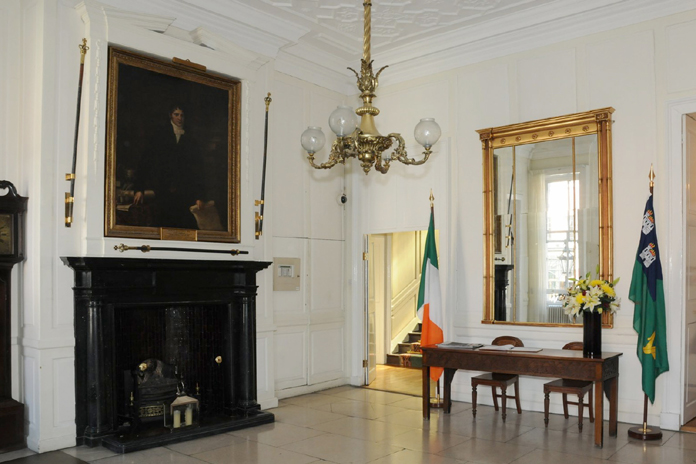
The Entrance Hall is one of the surviving original rooms and features panelling dating back to 1710. Over the Kilkenny marble chimneypiece hangs a portrait of Daniel O’Connell (1775-1847) by John Gubbins (fl. 1820s) of Limerick and Dublin. O’Connell was Lord Mayor of Dublin in 1841 and was the first Catholic to hold the office since 1690 and the first to be elected by democratic franchise.
Brass plaques commemorate international efforts to relieve the distress of the poor in Ireland in the nineteenth century. One carries the inscription: ‘Record of the Committee Appointed by the Secretary of State for the Colonies to Administer the Sum of 100,000 DOLLARS voted by the Parliament of the Dominion of Canada for the Relief of Distress in Ireland 1880’. A plaque unveiled in 1992 commemorates ‘the Generosity of THE CHOCTAW NATION of OKLAHOMA (forcibly removed from Mississippi in 1831) who together with FIRST NATIONS located in UPPER and LOWER CANADA responded with Immense Kindness and Compassion towards the Suffering Irish during our Great Famine of 1847’.
The Lady Mayoress Parlour
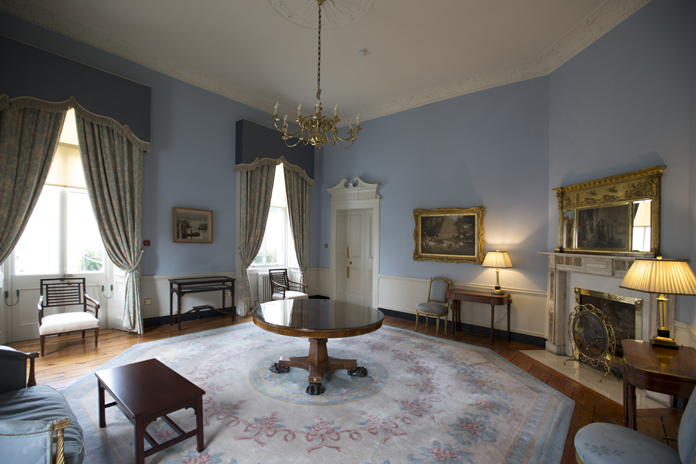
The Lady Mayoress Parlour, also known as “The Blue Room”, is presented largely as it would have appeared when first built by Joshua Dawson in 1710. The corner chimneypiece, installed in the late eighteenth century, is of veined white marble inlaid with yellow Siena marble panels. The overmantle mirror of gilded wood and plaster dates to the Regency period and features a late nineteenth-century Parisian print insert.
The simple, but effective plasterwork on the ceiling is by Charles Thorp (d. 1817), stuccodore, who was Lord Mayor of Dublin 1800. Thorp’s plasterwork also features in the City Hall and in townhouses in North Great George’s Street. The Adamesque plasterwork ceiling rose is echoed by the modern carpet handwoven by J.D. McMurray of Moyard, County Galway, to mark the Dublin City Millennium celebrations in 1988.
The Drawing Room
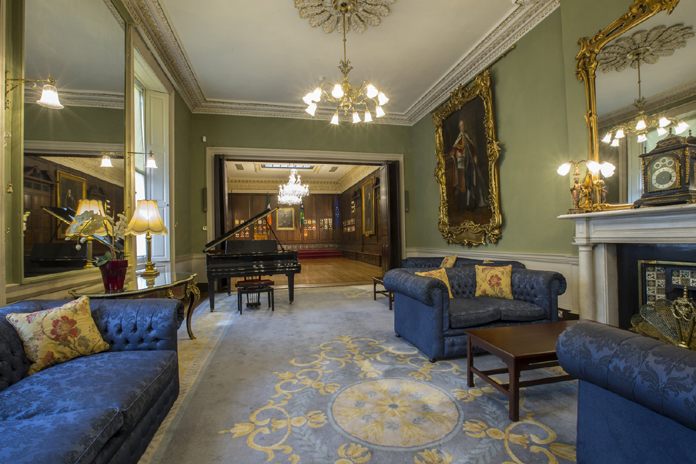
The Drawing Room was created in the 1760s by knocking-through a number of smaller rooms and today it is used for informal receptions. The Drawing Room features curvilinear pedimented doorcases, a pillared white marble chimneypiece, and gilt-edged Acanthus ceiling roses. The handsome clock on the chimneypiece is by Michael Anderson who worked in Parliament Street between 1872 and 1927. The chime of the right bell is a Westminster Chime, meaning that it sounds like Big Ben, while the chime on the left bell is silent.
On the left of the fireplace is a portrait of Field Marshal George Townshend (1724-1807), Viscount Townshend and Lord Lieutenant of Ireland from 1767 to 1772. He secured the passage of the Octennial Act, which limited the duration of Irish Parliaments to eight years and thereby ensured regular elections. Dublin City Assembly approved of this step on the road to democracy and, as a gesture of appreciation, commissioned the Dublin-born artist Thomas Hickey (1741-1824) to paint the Viscount’s portrait.
On the right of the fireplace is a portrait of Hugh Percy (1714-86), Earl of Northumberland, by Sir Joshua Reynolds (1723-92), the first President of the Royal Academy in London. Northumberland was appointed Lord Lieutenant of Ireland in 1763 and, although only serving a brief two-year term, was very popular in the post, being renowned for his hospitality at Dublin Castle.
The two portraits are set in magnificent gilded Rococo frames attributed to Richard Cranfield (1731-1809) of Dublin, one-time Master of the Guild of Carpenters.
The Oak Room
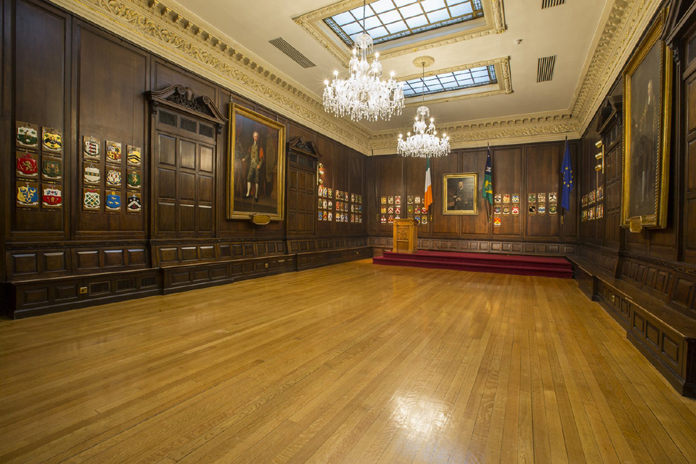
The top-lit Oak Room was built in 1715 as part of the purchase agreement between Dublin Corporation and Joshua Dawson. As the name suggests, it is panelled entirely in oak, most of which is original. A rich plasterwork cornice frames Georgian-style chandeliers produced by Waterford Crystal to compliment the room.
Portraits on display in the Oak Room relate to a critical event in Irish history, namely the passage of the Act of Union in 1800. On one side is a portrait of John Collon (1740-1828) who was the last Speaker of the Irish House of Commons. Foster worked to prevent the Act of Union from being passed but his efforts were in vain. The City of Dublin also opposed the Act of Union and commissioned the portrait from Hugh Douglas Hamilton (c.1740-1808) as a gesture of solidarity and support.
On the opposite side is a portrait of Richard Manders who was Lord Mayor of Dublin in 1801. This was a difficult time for the city as confidence was low following the closure of Parliament. Manders, however, attempted to lift society’s spirits by maintaining a high standard of hospitality at the Mansion House, which he financed out of his own pocket. The portrait was therefore commissioned for the Mansion House by a grateful city.
The portrait hanging over the central dais depicts Charles Stewart Parnell (1846-91) whose career was devoted to reversing the Act of Union and restoring the Irish Parliament. The posthumous portrait by Sir Thomas Alfred Jones (1823-93) is clearly an elegy for a lost leader who is shown at sunset in a brooding landscape with ruined abbey and Celtic Cross.
The Dining Room
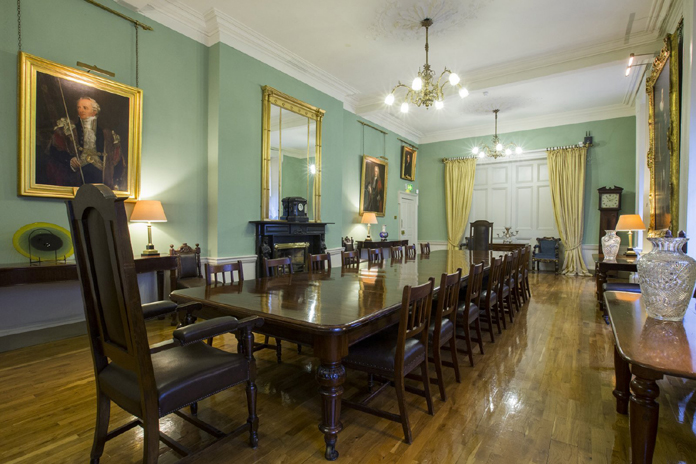
The Dining Room, like the Drawing Room on the opposite side of the Mansion House, was created in the 1760s and is today used for formal luncheons and small receptions. The centrepiece of the room, a black marble chimneypiece in the neo-Egyptian style, was installed in the 1830s.
Courtesy of Dublin City Council City Architects Division and Mary Clarke, City Archivist, with photography courtesy of the Office of the Lord Mayor of Dublin
Back to Building of the Month Archive